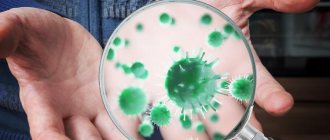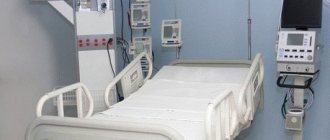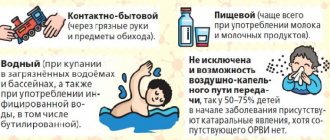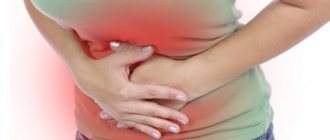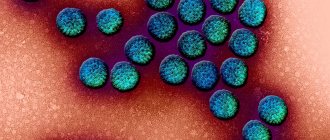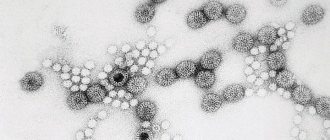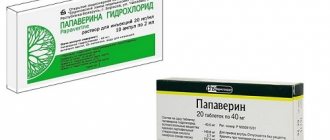Along with the epidemic of acute respiratory viral infections and ordinary flu, which affects the respiratory tract in winter, the incidence of intestinal infections of viral origin naturally increases. Many people mistake them for poisoning or indigestion, while others call the manifestations “stomach flu.” But in reality, the key culprits for these symptoms are rotavirus or norovirus. These infectious diseases are widespread and highly contagious, and outbreaks have recently been reported in major cities. But what can be done to stop their spread?
Rotavirus vs norovirus
Both of these viruses can provoke signs of an intestinal infection or “stomach flu” in children and adults.
But there are certain differences during the course of the disease. So, although the symptoms are generally typical - fever, diarrhea and vomiting, norovirus is faster and more active. Typically, the infection develops lightning fast and suddenly, accompanied by frequent vomiting and diarrhea. In normal healthy people, it lasts from 24 to 60 hours, and to get sick, short contact with a carrier of the infection is enough. Norovirus is the leading cause of acute diarrheal illness among adults. Up to 20 million cases are reported every year. When symptoms of norovirus or a similar viral infection called rotavirus occur in children, parents often refer to their child's illness as "stomach flu." However, this term is considered a misnomer because neither of these diseases is caused by the influenza virus.
Treatment of norovirus in adults
There is no specific treatment for norovirus in adults. Most often, the body copes with the infection on its own within a few days. In severe cases of the disease, the following is prescribed:
- antipyretics to reduce fever;
- probiotics and prebiotics to restore intestinal microflora;
- rehydration formulas to prevent dehydration.
In complex cases, treatment for norovirus takes place in a hospital. Patients are prescribed symptomatic therapy to eliminate intoxication, restore water-salt balance and prevent disturbances in the functioning of internal organs.
On a note
What is salmonellosis and why is it dangerous?
What is stomach flu?
The common term “stomach flu” is more correctly called acute gastroenteritis. It typically characterizes irritation and inflammation of the stomach or entire gastrointestinal tract, including the small and large intestines, which can cause diarrhea, vomiting and abdominal pain. Many viruses and various bacteria can cause symptoms called stomach flu, and this can be misleading. Therefore, doctors use more precise terms: gastroenteritis - if vomiting and diarrhea predominate, enterocolitis - if only diarrhea predominates, without vomiting. We wrote about how to survive the flu without consequences here.
Popular questions and answers
We asked popular questions about the treatment and prevention of norovirus in adults to our experts: Kirill Yuvchenko, a clinical laboratory diagnostics doctor, and Nikolai Dubinin, a sanitary doctor and epidemiologist . The experts' answers will be useful to anyone who has encountered norovirus gastroenteritis or would like to avoid this unpleasant disease.
What diet should you follow if you have norovirus?
Since we are talking about an intestinal infection, the diet should be gentle on the damaged mucous membrane of the gastrointestinal tract. It is worth excluding coarse fiber, marinades and hot sauces, seasonings, sweets, dairy products and, of course, alcohol. You need to give up coffee, carbonated drinks, vegetable and fruit juices. With viral gastroenteritis, the body loses water. Special rehydration formulations, which can be purchased at the pharmacy, will help restore the water-salt balance.
How many days do people get sick with norovirus?
The disease has a short incubation period, up to 48 hours. In most cases, norovirus infection is mild, and complete recovery occurs within the third or fourth day after the onset of symptoms.
How dangerous is norovirus?
The main danger of norovirus is dehydration. This condition can provoke cardiovascular and kidney failure, impaired blood circulation and the formation of blood clots. Therefore, those who have had norovirus are advised to monitor their body’s condition for some time. It makes sense to take blood tests a couple of weeks after recovery.
Which doctor should I see if I have norovirus?
The symptoms of norovirus gastroenteritis are very similar to many other intestinal infections, poisonings and diseases that require surgical treatment. Therefore, during diagnosis it is necessary to exclude: ● other viral and bacterial gastroenteritis; ● ulcerative lesions of the intestines; ● appendicitis; ● ectopic pregnancy; ● myocardial infarction.
An accurate diagnosis must be made by a general practitioner or infectious disease specialist. You may need to consult a specialist: a gastroenterologist and a surgeon.
When to call an ambulance if you have norovirus?
Norovirus gastroenteritis is usually mild, but there is still a risk of complications. The cause of a severe course of the disease can be a general weakening of the body, old age, decreased immunity due to medication and other diseases. Emergency medical care may be required for: ● elderly people; ● pregnant women; ● patients with severe dehydration; ● patients with pathologies of the kidneys and cardiovascular system.
You should immediately call an ambulance if the patient has an increased feeling of thirst, aching pain and cramps in the arms, and dry skin and mucous membranes. These symptoms indicate an imbalance of water and electrolytes and possible complications from the circulatory and urinary systems.
Sources
- Viral gastroenteritis: rotaviruses, noroviruses, adenoviruses. Ph.D. Taran Tatyana Viktorovna. https://snipchi.ru/updoc/2020/%D0%94%D0%BE%D0%BF%20% D0%BE%D0%B1%D1%80%D0%B0%D0%B7%D0%BE %D0%B2% D0%B0%D0%BD%D0%B8%D0%B5/5_4_TAR.pdf
- Clinical recommendations for providing medical care to children with norovirus infection. FSBI NIIDI FMBA OF RUSSIA, Public organization "Eurasian Society for Infectious Diseases", Public organization "Association of Infectious Disease Doctors of St. Petersburg and Leningrad Region" (AVISPO). https://www.ngdphmao.ru/doc/standart/Fed_9.pdf
- Norovirus infection of the gastrointestinal tract. I.V. Shestakova. Moscow State Medical and Dental University named after. A.I. Evdokimov Ministry of Health of the Russian Federation. https://medsestrajournal.ru/sites/default/files/fulltext-pdf/25879979-2014-08-06.pdf
How can you get infected?
Norovirus and rotavirus are the most common causative agents of this disease and are medically spread through the fecal-oral route. In other words, this is a classic disease of dirty hands: you didn’t wash your hands after using the toilet, before eating, or after communicating with sick people or riding in public transport. From dirty hands, the virus entered the mouth and led to infection. But we cannot ignore another way in which these highly contagious diarrheal diseases quickly spread from one victim to another. This is an airborne infection - the virus is transmitted with particles of mucus and saliva from sneezing and coughing sick people.
In addition, these viruses survive well in cool weather on various surfaces, in food and water, and they can often be transmitted in small groups when people stay in confined spaces for a long time.
Causes of norovirus in adults
The most common cause of norovirus in adults is contact with a virus carrier. In Europe in 2001–2006, several outbreaks of norovirus gastroenteritis were analyzed and it was found that in 88% of cases the source of infection was a sick person. Transmission of infection from sick to healthy occurred through airborne droplets and contact, through dishes and household items: door handles, furniture, computer keyboards, remote controls.
Sharing a laptop at home or work can also lead to norovirus infection. Photo: Pixabay
Other causes of norovirus in adults are consumption of contaminated food (10%) and water (2%). Most often, the source of infection is products that have not undergone heat treatment:
- greenery;
- fresh vegetables and fruits;
- ice cream.
Infection by water occurs if you drink water from the tap, unboiled or from a poorly treated cooler.
An indirect cause of norovirus in adults can be reduced immunity. Physically weakened people and patients with serious illnesses are more easily infected and suffer worse from viral gastroenteritis.
Difference between Norovirus and Rotavirus
Medical experts say it is difficult, if not impossible, to differentiate between norovirus and rotavirus based on symptoms alone. Typical for norovirus:
- Nausea;
- Vomit;
- Watery diarrhea;
- Abdominal pain;
- Fever;
- Body aches.
Rotavirus infection also manifests itself with symptoms such as:
- Vomit;
- Watery diarrhea;
- Fever;
- Abdominal pain;
- Dehydration.
The main differences between norovirus and rotavirus are based on who gets it, how long the infection lasts, and what complications are possible. Norovirus usually lasts no more than two and a half days, while rotavirus usually lasts three to eight days. Since rotavirus usually affects infants and young children, their fluid loss is more significant than in adults. Severe dehydration, especially in infants and young children, can be life-threatening.
Beware of norovirus! Basic symptoms and principles of treatment
There are several types of viruses that can cause symptoms of an intestinal infection in humans, and one of them is norovirus. It was first isolated in 1972 in the city of Norwalk (USA), so at first it was called the Norwalk virus.
Norovirus is extremely contagious: only 10-100 virus particles are needed to infect a person. That is why the entry of the virus into a children's group quite often leads to the rapid spread of infection among the entire group or class.
Main routes of transmission:
- through food, when a person becomes infected, for example, due to eating unwashed fruits and vegetables;
- through water, when a person drinks a liquid containing virus particles;
- through household items and unwashed hands.
Symptoms of norovirus infection
The first signs of the disease appear, as a rule, 6-48 hours after the virus enters the body:
- repeated vomiting (rarely - single);
- diarrhea (may be absent);
- severe nausea;
- temperature increase;
- abdominal pain.
Most often, norovirus causes both diarrhea and severe vomiting, but sometimes only vomiting can occur. Signs related to the digestive tract may be accompanied by other symptoms: muscle pain, headache, weakness. After an infection, the body develops immunity to the virus, but for a very short period of time - only about 8 weeks.
The signs of norovirus in children and adults are similar. The disease begins acutely, more often with vomiting and fever, less often with fever and diarrhea. Almost a third of patients have a runny nose, cough, sore throat, and children often develop bronchiolitis.*
Norovirus is dangerous because, like other intestinal infections, it can cause dehydration when the body loses fluid and important salts due to repeated vomiting and diarrhea. This condition is especially dangerous for young children. So if norovirus symptoms appear in children, treatment should be started immediately!
Treatment of norovirus infection
The most important thing is to stop diarrhea and replace fluid loss. There are proven means for this.
Replenishing fluid loss
For this purpose, it is necessary to use special solutions for oral rehydration. Plain water won't do! The fact is that with vomiting and diarrhea, the body loses not only water, but also salts, the balance of which is very important for health. For the treatment of norovirus in children, it is recommended to use solutions with reduced osmolarity (with reduced salt concentration) up to 250 mOsm/l. Such drugs improve the absorption of fluid, reduce the load on the child’s kidneys and reduce the total volume of fluid required for drinking.
Such a remedy is Adiarin® Rehydrocomplex® - a balanced mixture of electrolytes and glucose. An additional advantage of the drug is the inclusion of zinc in its composition, which helps strengthen local immunity and reduce the duration of diarrhea. Adiarin® Rehydrocomplex® allows you to prevent the development of dehydration, quickly restore water and electrolyte balance and avoid the serious consequences of intestinal infection.
The product can be used in children from birth, it has a pleasant taste, reduces the feeling of nausea and does not provoke vomiting. It is recommended to take it from the moment the first signs of illness appear until the complete cessation of diarrhea and vomiting. It is best to give the solution in small portions so as not to provoke vomiting.
Stopping diarrhea
To stop diarrhea, you can use a product suitable for the whole family, including children from 3 months - Adiarin® based on the natural substance - tannat gelatin. It creates a protective barrier on the surface of the intestinal mucosa that can protect it from the action of viruses and their toxins. Adiarine® allows you to reduce the frequency of stools within the first 12 hours** and stop the loss of water and electrolytes, and also helps relieve abdominal pain and nausea.
An important advantage of Adiarin® is its neutral taste, which does not cause rejection in children, and a small dose for a single dose.
Restoration of intestinal microflora
Any intestinal infection negatively affects the intestinal microflora and immunity. So after suffering from norovirus, it is important to take care of the health of the digestive system.
Adiarin® Probio can be used to restore intestinal microflora. The drug contains a special combination of the most studied strains in pediatrics: lactobacilli LGG® and bifidobacteria BB-12®. These strains have a proven antidiarrheal effect. The product protects microflora and strengthens local immunity of the intestinal mucosa.
Adiarin® Probio comes in oil drops and can be taken alone or added to food or drinks. To restore microflora, it is enough to take only 6 drops once a day.
Adiarin® products are comprehensive care for norovirus infection for all family members, especially children. They can effectively stop diarrhea, prevent the development of dehydration and restore the intestinal microflora after a norovirus infection.
* Shestakova I.V. Norovirus infection / Consilium Medicum. 2013. Vol. 15. No. 12
** Çağan E, Ceylan S, Mengi Ş, Çağan HH./ Evaluation of Gelatin Tannate Against Symptoms of Acute Diarrhea in Pediatric Patients / Medical Science Monitor: International Medical Journal of Experimental and Clinical Research. 2017;23:2029-2034.
THERE ARE CONTRAINDICATIONS. BEFORE USE, YOU SHOULD READ THE INSTRUCTIONS FOR USE AND/OR CONSULT WITH A SPECIALIST.
Features of these two infections
Rotavirus has been the most common cause of acute diarrheal disease in children worldwide for many years. This was before the advent of vaccination against this disease. Currently, highly effective vaccines for infants provide protection against infection. But this is only relevant for those countries where this vaccination is given to children as part of the national calendar. In our country, rotavirus is still widespread and quite dangerous for many categories of people.
Although children can become infected with norovirus, the virus is more common in adults.
The infection is different from diarrhea due to chronic conditions such as inflammatory bowel disease, or "travelers' diarrhea" during travel abroad. Although norovirus usually clears up more quickly, the infectious disease can greatly harm vulnerable populations, such as the elderly, those with underlying health conditions, or those who are pregnant. The main complication of any of these infections is considered to be severe dehydration, which, for example, can send young children or older people to the hospital. Adults exposed to rotavirus as children usually develop lifelong immunity to it. But with norovirus, everything is more complicated: a person can become infected with it more than once. It is more difficult for the body to create protection against infection because the virus mutates much more often and acquires new properties. In addition, there is no effective vaccine for it.
Treatment of "stomach flu"
Experts say there is no effective treatment other than enduring the symptoms of illnesses until they go away.
Today, there are no proven treatments or effective drugs that reliably shorten the duration of the disease or significantly alleviate symptoms. Anti-diarrhea medications (syrups, tablets or powders) usually do not help. However, experts emphasize the importance of adequate hydration, including electrolytes, while you are sick with norovirus or rotavirus. Rehydration drinks such as Oralit, Regidron, Glucosolan or others can help prevent more serious complications of dehydration. Regular fluid intake gradually replenishes the dangerous loss of water from cells and tissues. This is a proven way to get better faster and avoid ending up in the hospital. But sometimes young children cannot drink enough fluid to fully compensate for losses from vomiting and diarrhea. They need intravenous fluids.
How to prevent the spread of "stomach flu"?
The fact that there are no proven effective treatments for norovirus and rotavirus is another reason their spread is difficult to control, experts say.
Prevention includes vaccinating children against rotavirus. Depending on the vaccine, shots are given when the child is 2, 4 and 6 months old, or only 2 and 4 months old. Of course, the most important thing anyone can do to protect against the spread of norovirus and rotavirus, other than getting vaccinated against the disease, is hand washing. The best method for removing viruses from your hands is to use soap and water. Alcohol-containing liquids and gels are not as effective. You are unlikely to inactivate these robust viruses. In addition, alcohol greatly dries the skin and damages its protective layer.
When washing your hands, make sure you clean them thoroughly for at least 20 seconds. Also, regularly wipe down frequently touched surfaces and avoid preparing food when you are sick. While you are sick, stay home until you are fully recovered. A healthy person is unlikely to die from one of these infections, but if you infect a child or older person, it can cause dangerous consequences.
Be carefull
Because there are various diseases that can cause gastrointestinal distress, it is important not to assume that you have norovirus or rotavirus. And be attentive to the dynamics of symptoms, which may indicate the need for immediate medical examination.
Adults and children should not have a high fever due to rotavirus or norovirus.
Viral gastroenteritis often causes a short-lived fever, but it is usually less than 38.0℃ in adults. A high temperature above these numbers, especially with chills, is more suggestive of bacterial infections such as salmonellosis, which may require antibiotics. It's more difficult with children. They may have a fairly high fever even with mild infections, although there are usually no chills. Symptoms in infants tend to be difficult to recognize, so it is important for parents to monitor young children even more closely.
Here are other signs of anxiety to watch out for:
- Inability to take in as much fluid as you lose;
- Severe abdominal pain;
- Blood in your vomit or diarrhea.
If you have any of these symptoms, consult your doctor immediately.
If you contract norovirus or rotavirus, doctors stress the importance of washing your hands regularly and treating it at home without rushing back to work. Wait until you are better so you don't spread one of these highly contagious diseases to anyone else. We wrote more about how to treat rotavirus in a child here.
Concepts and causes of the disease
Recently, rotavirus and norovirus were not separated, and the diagnosis was rotavirus infection. The types of intestinal diseases are similar, but the symptoms and course of the disease differ.
Norovirus infection was discovered in the early 70s of the twentieth century in the USA. Infection occurs in public places (kindergartens, educational, entertainment institutions), through contact, in the presence of the virus in the air. Norovirus affects all people, but children and people with weakened immune systems suffer more severely.
50% of infectious diseases in adults and 30% in schoolchildren are caused by noroviruses. Children under seven years of age are more likely to get rotavirus.
Norovirus infection is transmitted through the oral-fecal and respiratory routes. The virus is acquired through unwashed vegetables, fruits, unboiled water, door handles, and toilet rims.
Norovirus intestinal infection is contagious. The virus is resilient and is not afraid of cold or hot temperatures; killed by cleaning disinfectants with chlorine.
A person who has recovered from the infection develops immunity to infection for up to 7-8 weeks.
Rotavirus infection, intestinal flu, is an infectious disease caused by rotavirus. The infection affects adults and children. The patient is contagious throughout the entire period of illness, about a week. A person who has recovered from the disease develops immunity to rotavirus.
The cause of infection is eating unwashed vegetables and fruits, and eating food with dirty hands.
You can catch the infection through the respiratory route, by coughing or runny nose. Rotaviruses tolerate cold and do not die in chlorinated water.
